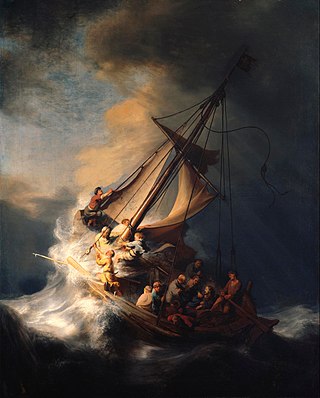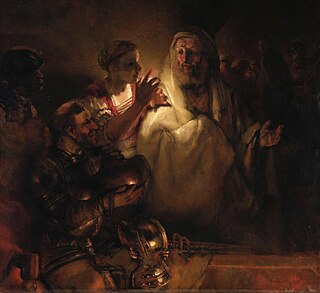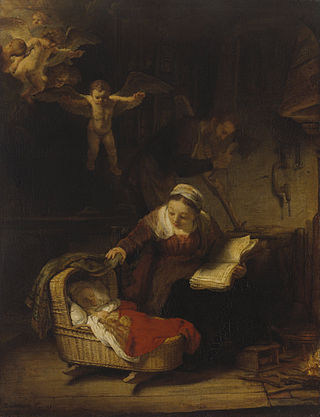
The Mauritshuis is an art museum in The Hague, Netherlands. The museum houses the Royal Cabinet of Paintings which consists of 854 objects, mostly Dutch Golden Age paintings. The collection contains works by Johannes Vermeer, Rembrandt van Rijn, Jan Steen, Paulus Potter, Frans Hals, Jacob van Ruisdael, Hans Holbein the Younger, and others. Originally, the 17th-century building was the residence of count John Maurice of Nassau. It is now the property of the government of the Netherlands and is listed in the top 100 Dutch heritage sites.

Militia Company of District II under the Command of Captain Frans Banninck Cocq, also known as The Shooting Company of Frans Banning Cocq and Willem van Ruytenburch, but commonly referred to as The Night Watch, is a 1642 painting by Rembrandt van Rijn. It is in the collection of the Amsterdam Museum but is prominently displayed in the Rijksmuseum as the best-known painting in its collection. The Night Watch is one of the most famous Dutch Golden Age paintings.

Jan Lievens was a Dutch Golden Age painter who was associated with his close contemporary Rembrandt, a year older, in the early parts of their careers. They shared a birthplace in Leiden, training with Pieter Lastman in Amsterdam, where they shared a studio for about five years until 1631. Like Rembrandt he painted both portraits and history paintings, but unlike him Lievens' career took him away from Amsterdam to London, Antwerp, The Hague and Berlin.

Rembrandt Harmenszoon van Rijn, usually simply known as Rembrandt, was a Dutch Golden Age painter, printmaker and draughtsman. An innovative and prolific master in three media, he is generally considered one of the greatest visual artists in the history of art and the most important in Dutch art history. It is estimated Rembrandt produced a total of about three hundred paintings, three hundred etchings and two thousand drawings.

The Soviet sale of Hermitage paintings in 1930 and 1931 resulted in the departure of some of the most valuable paintings from the collection of the State Hermitage Museum in Leningrad to Western museums. Several of the paintings had been in the Hermitage Collection since its creation by Empress Catherine the Great. About 250 paintings were sold, including masterpieces by Jan van Eyck, Titian, Rembrandt, Rubens, Raphael, and other important artists. Andrew Mellon donated the twenty-one paintings he purchased from the Hermitage to the United States government in 1937, which became the nucleus of the National Gallery of Art in Washington, D.C.

Jacob J. Hinlopen lived in a house with Hinlopen in the gable, now at 155 Nieuwendijk. He traded in cloth and Indian wares. In 1602 he was co-founder of the Dutch East India Company in Enkhuizen: his descendants inherited very old stocks. In 1617 he became the first person of Flemish origin to obtain a seat on the City Council.

Aristotle with a Bust of Homer, also known as Aristotle Contemplating a Bust of Homer, is an oil-on-canvas painting by Rembrandt that depicts Aristotle wearing a gold chain and contemplating a sculpted bust of Homer. It was created as a commission for Don Antonio Ruffo's collection. It was bought and sold by several collectors until it was eventually purchased by the Metropolitan Museum of Art. The mysterious tone in the painting has led several scholars to different interpretations of Rembrandt's theme.

Fourteen Rembrandt paintings are held in collections in Southern California. This accumulation began with J. Paul Getty's purchase of the Portrait of Marten Looten in 1938, and is now the third-largest concentration of Rembrandt paintings in the United States. Portrait of Marten Looten is now housed at the Los Angeles County Museum of Art (LACMA).

Self Portrait is an oil-on-canvas painting by the Dutch artist Rembrandt. Painted in 1652, it is one of more than 40 painted self-portraits by Rembrandt, and was the first he had painted since 1645. In composition it is different from his previous self-portraits, depicting the painter in a direct frontal pose, hands on his hips, and with an air of self-confidence. It was painted the year that his financial difficulties began, and breaks with the sumptuous finery he had worn in previous self-portraits. Art historian Christopher White has called it "one of the most magisterial and sombre of these (late) pictures". It is in the Kunsthistorisches Museum in Vienna.

Portrait of a Young Man with a Gold Chain is an oil painting usually attributed to the Dutch painter Rembrandt. Signed and dated 1635, it was traditionally regarded as a self-portrait, although contemporary criticism tends to challenge this hypothesis.

The dozens of self-portraits by Rembrandt were an important part of his oeuvre. Rembrandt created approaching one hundred self-portraits including over forty paintings, thirty-one etchings and about seven drawings; some remain uncertain as to the identity of either the subject or the artist, or the definition of a portrait.

The Head of Christ is a 1648 oil-on-panel painting by the Dutch artist Rembrandt. It is now in the Gemäldegalerie in Berlin.

Flora or Saskia as Flora is a 1634 oil-on-canvas painting by Rembrandt, depicting his wife Saskia van Uylenburgh as the goddess Flora. It is held by the Hermitage Museum in St. Petersburg.

Titus as a Monk or Rembrandt's Son Titus in a Monk's Habit is a 1660 oil-on-canvas painting by the Dutch artist Rembrandt, showing his son Titus in the habit of a Franciscan monk. It is now in the collection of the Rijksmuseum in Amsterdam.

The Denial of Peter is a 1660 painting by Rembrandt, now in the Rijksmuseum in Amsterdam. It depicts the denial of Peter, an event in the Passion of Jesus.

Portrait of Catharina Hooghsaet (1607–1685) is a 1657 painting by the Dutch Golden Age painter Rembrandt.

The Holy Family with Angels (1645) is an oil painting on canvas by the Dutch painter Rembrandt. It is an example of Dutch Golden Age painting and is now in the collection of the Hermitage Museum.

Lucretia is a 1666 history painting by the Dutch Golden Age painter Rembrandt Harmensz van Rijn in the collection of the Minneapolis Institute of Art. It is an oil painting on canvas that depicts a myth about a woman named Lucretia who lived during the ancient Roman eras. She committed suicide to defend her honor after being raped by an Etruscan king's son. For her self-sacrifice she is known as a heroine to the Romans, who celebrated the feminine ideals of virtue and chastity.

Courtesan at her Mirror or Young Woman with Earrings is a 1657 painting by Rembrandt. In 1781 it and 118 other works were sold by the Paris-based collector Sylvain-Raphaël de Baudouin to Catherine II of Russia via Melchior Grimm. It is now in the Hermitage Museum.

The Standard Bearer is a three-quarter-length self-portrait by Rembrandt formerly in the Paris collection of Elie de Rothschild, and purchased by the Rijksmuseum for 175 million euros with assistance from the Dutch state and Vereniging Rembrandt in 2021. It was painted on the occasion of the artist's move from Leiden to Amsterdam and is seen as an important early work that "shows Rembrandt's ambition to paint a group portrait for the Amsterdam militia, at the time the most valued commission a painter could be awarded."




















